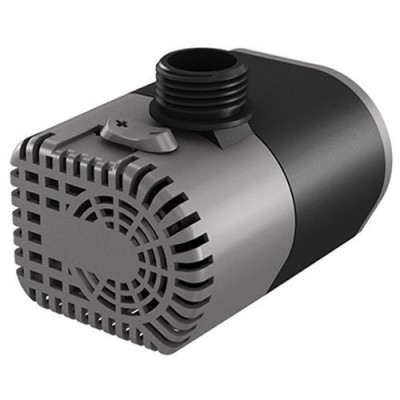Pond Pumps Canada is part of the Amazon Affiliate Network. We may receive payment for items purchased through the Amazon website.
The 160 GPH Active Aqua Submersible Pump was built to go below the waterline in your pond. Active Aqua's entire collection of pumps complete any grow setup, but for hydroponic systems, you can't beat the submersible line. All of Active Aqua's submersible pumps include multiple hose fittings so you get an exact fit every time. Each pump's powerful mag drive construction includes removable foam filters, impellers, rubber mounting feet to reduce vibration, and a 10-foot heavy duty power cord. The Active Aqua Submersible Pump moves 160 gallons per hour and is recommended for 15 plus gallon reservoirs, but you can adjust the pump's flow to move at your preferred rate. And as an added bonus, with its dependable design, feel free to use this pump inside or outside.
- Active aqua submersible pumps designed specifically for hydroponic systems
- Powerful mag drive construction, removable foam filters and impellers
- Included indoor/outdoor use; oil free/environmentally safe
- Easy open shroud for filter replacement; rubber mounting feet reduce vibration
- Recommended for 15-Gallons reservoir
Hydrofarm AAPW160 160-GPH Active Aqua Submersible Pump
- Brand: Active Aqua
- Product Code: AAPW160
- Availability: In Stock
Related Products
Hydrofarm AAPA15L 6-Watt 15-LPM Active Aqua Air Pump with 4 Outlets
AAPA15L Features: -Air pump. -With 4 outlets, 15L per minute..
Active Aqua T Connector, 1/2-Inch, 10-Pack
10 pieces per packUse to combine up to three tubing lines to..
Dynamic Head
The effect of the Earths gravity on the "lift" or head pressure is fairly simple; for every vertical foot of distance the pump moves the water you are adding one foot of head pressure so the ratio is a 1:1 ratio. The effects of the friction, caused by water as it travels through your hose or pipes, on the total head pressure is a little more difficult to calculate especially as there are slight variations in pipe friction in different hose materials and the smoothness of the inner bore. Basically. for every ten feet of pipe through which the water has to travel travel horizontally will contribute 1 foot of head height; the ratio of the pipe friction loss is a 10:1 ratio.Plumbing fixtures and bends and corners in your hose also increase the total head you must calculate to ensure the proper final volume from your pump. Every corner with a 90 degree elbow in your plumbing will add 1 foot of head pressure with a 1:1 ratio. 45 degree elbows, tees and even insert couplers can all have an impact on the final flow.
If you install a pump 40 feet away from the top of your waterfall which is 6 feet above the pump and the tubing is a single run of 40 feet horizontally then you add 4 feet of head for the tubing length (the 10:1 ratio) to the 6 foot differnetial between the pump location and the final height of the waterfall so your final total dynamic head calculation would be 10 feet. This means your final volume of water flow in this water feature or application would be the volume of flow on the performance curve that equaled the gallons per hour at 16 feet. This volume will certainly be much less than the initial volume the pump can move at an open flow or a zero head.
If in the above example your 40 feet of horizontal tubing run also required 3 elbows of 90 degrees then an additional 3 feet of theoretical head would be added and your final flow result would be at 19 feet on the performance curve of the pump. In this example you would want to choose a pump that has the desired GPH rating at 9 feet of head pressure. Tubing size is also an important factor in accounting for head pressure loss, in general you should never reduce the diameter of the tubing below what the output size of the pump is, this will drastically increase head pressure, and reduce pump performance. For maximum pump performance, using the largest tubing that is practical is the best choice. A best practice is to use a hose with an inner diameter that is the same as your pumps outlet fitting.

